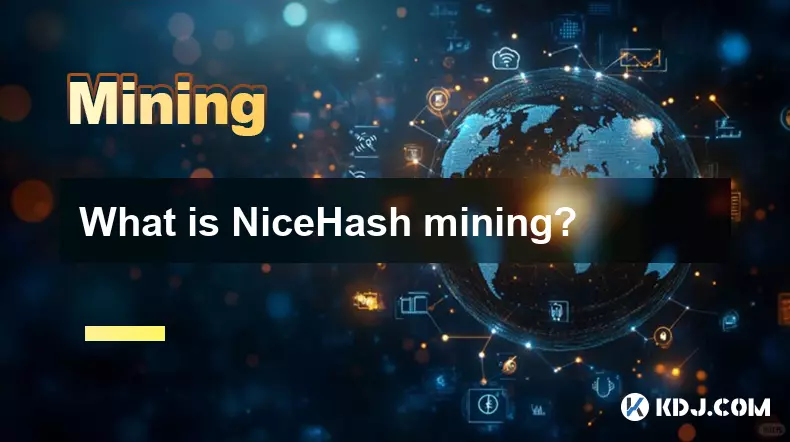-
 bitcoin
bitcoin $102877.190955 USD
1.88% -
 ethereum
ethereum $3430.435064 USD
4.52% -
 tether
tether $0.999264 USD
-0.05% -
 xrp
xrp $2.307310 USD
4.49% -
 bnb
bnb $987.740692 USD
3.82% -
 solana
solana $161.947760 USD
3.97% -
 usd-coin
usd-coin $0.999712 USD
-0.05% -
 tron
tron $0.292810 USD
2.93% -
 dogecoin
dogecoin $0.179738 USD
10.70% -
 cardano
cardano $0.580716 USD
8.75% -
 hyperliquid
hyperliquid $42.463448 USD
8.40% -
 chainlink
chainlink $15.763437 USD
7.05% -
 zcash
zcash $649.595636 USD
17.21% -
 bitcoin-cash
bitcoin-cash $511.610261 USD
7.19% -
 stellar
stellar $0.292537 USD
7.91%
What is Hashrate?: An Essential Explainer for Every Crypto Miner.
Hashrate measures the total computational power securing a blockchain, with higher hashrate enhancing network security and miner profitability.
Nov 04, 2025 at 07:14 pm

What Is Hashrate and Why It Matters in Cryptocurrency Mining
1. Hashrate refers to the total computational power used by miners to process blocks on a blockchain network. It measures how many times per second a miner or group of miners can attempt to solve the cryptographic puzzle required to validate transactions and create new blocks. The higher the hashrate, the more secure and resilient the network becomes against potential attacks.
2. In proof-of-work blockchains like Bitcoin, miners compete to find a valid hash that meets the network’s difficulty target. This process involves repeatedly changing a small piece of data called the nonce and hashing the block header until a suitable result is found. Each attempt counts as one hash, and the collective number of these attempts across the network constitutes the global hashrate.
3. A high hashrate indicates strong network security because it means a large amount of computing power is dedicated to maintaining the blockchain’s integrity. An attacker would need to control more than 50% of this hashrate to carry out a successful double-spending attack, which becomes increasingly impractical as the hashrate grows.
4. For individual miners, hashrate directly affects profitability. Miners with greater computational output have a higher probability of solving the next block and earning the associated block reward and transaction fees. As such, upgrading mining hardware to increase personal hashrate is a common strategy among competitive operators.
How Hashrate Is Measured and Tracked
1. Hashrate is typically measured in hashes per second, with standard units including kilohashes (KH/s), megahashes (MH/s), gigahashes (GH/s), terahashes (TH/s), and petahashes (PH/s). Bitcoin’s network, for example, operates at several hundred exahashes per second (EH/s), reflecting the immense scale of computational effort involved.
2. Public blockchain explorers and analytics platforms like Blockchain.com, Glassnode, and BitInfoCharts provide real-time tracking of network hashrate. These tools allow miners, investors, and analysts to monitor fluctuations that may indicate changes in mining activity, hardware upgrades, or shifts in energy costs affecting miner participation.
3. Sudden drops in hashrate can signal large-scale miner shutdowns, often due to regulatory crackdowns or spikes in electricity prices. Conversely, sustained increases usually reflect growing confidence in the network or the deployment of more efficient mining rigs.
4. Estimating hashrate isn’t done by directly observing every miner’s output. Instead, it’s inferred from the time intervals between mined blocks and the current difficulty level. When blocks are solved faster than the target interval (e.g., 10 minutes for Bitcoin), the network adjusts difficulty upward, and this adjustment helps calculate the approximate total hashrate.
The Relationship Between Hashrate, Difficulty, and Mining Rewards
1. Network difficulty and hashrate are dynamically linked. As more miners join the network and contribute computational power, the overall hashrate rises. To maintain consistent block production times, the protocol automatically increases the difficulty of the cryptographic puzzle, ensuring that blocks aren’t generated too quickly.
2. Difficulty adjustments act as a self-regulating mechanism, preserving the stability of the blockchain regardless of how much hashrate enters or leaves the network. For instance, Bitcoin adjusts its difficulty approximately every 2,016 blocks, or roughly every two weeks, based on the average time taken to mine previous blocks.
3. While individual block rewards remain fixed until halving events, the likelihood of earning them depends on a miner’s share of the total hashrate. A miner contributing 1% of the network’s hashrate can expect to win about 1% of the blocks over time, assuming stable conditions.
4. Mining pools aggregate the hashrate of multiple participants to increase their chances of finding blocks. Rewards are then distributed proportionally based on each member’s contributed hashrate, making it feasible for smaller miners to earn consistent returns despite the high global competition.
Factors That Influence Hashrate Trends
1. The availability and efficiency of mining hardware significantly impact hashrate. Advances in ASIC (Application-Specific Integrated Circuit) technology enable newer models to deliver higher hashrate per watt, encouraging older machines to be phased out and driving up the network’s overall performance.
2. Energy costs play a crucial role. Miners tend to operate in regions where electricity is cheap and abundant, such as areas with surplus hydroelectric or geothermal power. Changes in local regulations or energy pricing can prompt mass relocations of mining operations, leading to measurable shifts in regional and global hashrate distribution.
3. Market price of the cryptocurrency being mined influences miner behavior. When prices rise, more participants are incentivized to mine, increasing the hashrate. Conversely, prolonged low prices may force less efficient miners offline, reducing total network hashrate until equilibrium is restored.
4. Regulatory environments also affect hashrate concentration. Countries that ban or restrict cryptocurrency mining often see sharp declines in local mining activity, redirecting hashrate to more accommodating jurisdictions. Historical examples include China’s 2021 mining crackdown, which caused a temporary global hashrate drop before operations migrated elsewhere.
Frequently Asked Questions
How does hashrate affect transaction confirmation speed?Hashrate itself doesn’t directly change how fast transactions are confirmed, as block intervals are maintained through difficulty adjustments. However, a stable and high hashrate ensures consistent block production and protects against disruptions that could delay confirmations.
Can a low hashrate make a cryptocurrency unsafe?Yes. Blockchains with very low hashrate are more vulnerable to 51% attacks, where a single entity gains majority control and manipulates transaction history. Smaller altcoins with limited mining activity are particularly at risk compared to major networks like Bitcoin.
Is higher hashrate always better for a blockchain?Generally, yes. A higher hashrate enhances security and decentralization by making attacks prohibitively expensive. However, excessive centralization of hashrate among a few large players or pools can introduce different risks, even if the total computational power is high.
Disclaimer:info@kdj.com
The information provided is not trading advice. kdj.com does not assume any responsibility for any investments made based on the information provided in this article. Cryptocurrencies are highly volatile and it is highly recommended that you invest with caution after thorough research!
If you believe that the content used on this website infringes your copyright, please contact us immediately (info@kdj.com) and we will delete it promptly.
- BlockDAG, Avalanche, Dogecoin: Crypto's Leading Trio in 2025
- 2025-11-07 22:05:01
- Layer 2 Coins: Will There Be a Potential Explosion by 2026?
- 2025-11-07 16:50:02
- Filecoin, ICP, and the AI Infrastructure Renaissance: Is History Repeating?
- 2025-11-07 16:50:02
- Bitcoin's Wild Ride: Surges, Zeros, and the Search for Stability
- 2025-11-07 17:05:01
- XRP, Bitcoin, and the Rally: What's the Deal, New York?
- 2025-11-07 17:25:01
- Filecoin, DePIN, and a Technical Breakout: What's the Buzz?
- 2025-11-07 17:05:01
Related knowledge

What is the block reward in mining?
Nov 06,2025 at 12:35am
Understanding Block Rewards in Cryptocurrency Mining1. The block reward is the incentive miners receive for successfully validating and adding a new b...

How do mining algorithms work?
Nov 06,2025 at 04:59am
Mining Algorithms and Their Role in Blockchain Networks1. Mining algorithms serve as the backbone of blockchain consensus mechanisms, ensuring that tr...

What is NiceHash mining?
Nov 06,2025 at 07:40am
NiceHash mining refers to the process of renting out computational power to individuals or organizations seeking to mine cryptocurrencies without owni...

Does an antivirus program affect mining?
Nov 05,2025 at 09:29pm
Understanding Decentralized Exchanges in the Crypto Ecosystem1. Decentralized exchanges (DEXs) operate without a central authority, allowing users to ...

What is the history of Bitcoin mining?
Nov 05,2025 at 08:15pm
Within the fast-moving world of cryptocurrency, new developments emerge daily, reshaping how investors, developers, and institutions interact with dig...

How is the energy consumption of mining justified?
Nov 05,2025 at 10:20pm
Energy Consumption in Cryptocurrency Mining1. The energy consumption associated with cryptocurrency mining has drawn significant attention from enviro...

What is the block reward in mining?
Nov 06,2025 at 12:35am
Understanding Block Rewards in Cryptocurrency Mining1. The block reward is the incentive miners receive for successfully validating and adding a new b...

How do mining algorithms work?
Nov 06,2025 at 04:59am
Mining Algorithms and Their Role in Blockchain Networks1. Mining algorithms serve as the backbone of blockchain consensus mechanisms, ensuring that tr...

What is NiceHash mining?
Nov 06,2025 at 07:40am
NiceHash mining refers to the process of renting out computational power to individuals or organizations seeking to mine cryptocurrencies without owni...

Does an antivirus program affect mining?
Nov 05,2025 at 09:29pm
Understanding Decentralized Exchanges in the Crypto Ecosystem1. Decentralized exchanges (DEXs) operate without a central authority, allowing users to ...

What is the history of Bitcoin mining?
Nov 05,2025 at 08:15pm
Within the fast-moving world of cryptocurrency, new developments emerge daily, reshaping how investors, developers, and institutions interact with dig...

How is the energy consumption of mining justified?
Nov 05,2025 at 10:20pm
Energy Consumption in Cryptocurrency Mining1. The energy consumption associated with cryptocurrency mining has drawn significant attention from enviro...
See all articles





















![The Graph Price Prediction [GRT Crypto Price News Today] The Graph Price Prediction [GRT Crypto Price News Today]](/uploads/2025/11/07/cryptocurrencies-news/videos/690d4df44fe69_image_500_375.webp)



















































